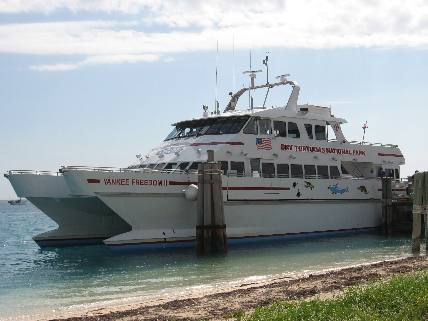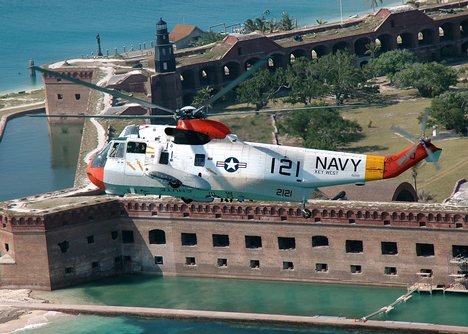Inside Ft JeffersonAn "inside" look at Fort Jefferson in the Dry Tortugas
Built in the mid-1800’s, with over 16 million bricks, Fort Jefferson is America’s largest coastal fort. Originally constructed to protect the important Gulf of Mexico shipping lanes it never fired a shot and was never officially completed before construction stopped and the fort abandoned in 1874. It was used for several things during its life time. Fort Jefferson was used as a military prison during the Civil War. During this time, it was "home" to Dr. Samuel Mudd, who was convicted of complicity in the assassination of President Abraham Lincoln.
An "inside" look at Fort Jefferson in the Dry Tortugas
Fort Jefferson is the largest brick fort in the Western Hemisphere. Fort Jefferson is made up of over 16 million bricks. Construction of Fort Jefferson lasted over 30 years, and it was never officially finished when construction was stopped in 1874.
Trees growing inside Fort Jefferson in the Dry Tortugas
Several varieties of trees survive inside the walls of Fort Jefferson. During spring and fall migrations many neo-tropical birds stop off here making it one of the top birding spots in the U.S. during certain times of the year. 16-million bricks were used in the construction of Fort Jefferson in the Dry Tortugas
U.S. Military attention was drawn to the keys in the early 1800's due to their strategic location in the Florida Straits. The United States knew it could control navigation to the Gulf of Mexico and protect Atlantic bound Mississippi River trade by fortifying the Tortugas. All ships entering the Gulf of Mexico had to pass near the Dry Tortugas and Garden Key in the Dry Tortugas was close to a protected deep water harbor. Whoever, controlled the Dry Tortugas and that protected harbor could effectively control shipping in the Gulf of Mexico. The first construction on Garden Key, in 1825, was a lighthouse to warn sailors of rocky shoals. Construction of Fort Jefferson did not began until 1846. Work continued on the fort for 30-years but the fort was never completed before being abandoned in 1874.
View from the only "land" outside Fort Jefferson on Garden Key in the Dry Tortugas
Fort Jefferson was built to protect one of the most strategic deepwater anchorages in North America. By fortifying this spacious harbor, the United States maintained an important “advance post” for ships patrolling the Gulf of Mexico and the Straits of Florida. Nestled within the islands and shoals that make up the Dry Tortugas, the harbor offered ships the chance to re– supply, refit, or seek refuge from storms. The location of the Tortugas along one the world’s busiest shipping lanes was its greatest military asset. Though passing ships could easily avoid the largest of Fort Jefferson’s guns, they could not avoid the warships that used its harbor. OK, now you need to know how to get to Fort Jefferson.
Yankee Freedom II is the ferry to Garden Key and Fort Jefferson in Dry Tortugas National Park
Since Garden Key and Fort Jefferson are located in the Dry Tortugas 70-miles west of Key West the only way to get here is by boat or sea plane. We opted for the "boat" option and took the Yankee Freedom II ferry from Key West to Fort Jefferson in the Dry Tortugas. The 70-mile ride each way on the Yankee Freedom II is a special treat itself. It takes you past other islands in the Florida Keys chain of islands. However, these islands are not connected to the mainland by bridge. Once you leave Key West Harbor on the Yankee Freedom II you are heading into an area only accessible by boat or sea plane. Thirty miles from Key West the Yankee Freedom II takes you past the Marquesas Keys and thousands of lobster trap buoys and the boats working these lobster traps. The Yankee Freedom II is the ferry service that transports visitors to Dry Tortugas National Park every day.
Chuck "Big Daddy" Meier provided me with this picture of a Navy H-3 Sikorsky helicopter from NAS Key West flying over Ft Jefferson in the Dry Tortugas
This is one of the Naval Air Station Key West H-3 Sea King helicopters doing a resupply to the National Park in the Dry Tortugas. Our friend Chuck says he loved those missions. Chuck used to be a rescue swimmer when he was in the navy and would fly on missions out to Ft Jefferson. It seems that after making their resupply the crew would get a little R&R on a secluded beach 70 miles from nowhere. It was great. Primitive camping at it's best. Actually, the place where "Big Daddy" and his Navy buddies camped wasn't at Ft Jefferson in the Dry Tortugas. Instead they would set down and camp on Loggerhead Key which is a bit west of Ft Jefferson in the Dry Tortugas. Loggerhead Key is the island with the light house that is visible from Ft Jefferson. The Navy has replaced the H-3's with the H-60's. Nothing stays the same. I want to thank "Big Daddy" for giving me this picture. Big Daddy is a friend of ours that currently works in the Steel Horse Saloon in Key West. However, Big Daddy was once stationed in Pensacola, Florida where we live. Big Daddy, had an exciting Navy career as a Rescue Swimmer. Big Daddy's next adventure in life was as a contractor, where he was deployed both inside and outside the US with companies like Blackwater and SOC. To places on the planet that needed a certain skill set to assure ones survivability. Chuck wrote a book about his experiences in Iraq that you may find
interesting: You can order his "Book
"Letters from the Sand Box Chuck currently resides in Key West with his wife Dallas and works at the world famous Steel Horse Saloon. Chuck aka "Big Daddy" Charles Meier during good times in the Iraq Sand Box Chuck aka "Big Daddy" experiences a Bad Day in the Sand Box Chuck aka "Big Daddy" Charles Meier's Life as a Rescue Swimmer for the US Navy Chuck aka "Big Daddy" Meier at the world famous Steel Horse Saloon Order "Big Daddy's" Book "Letters from the Sand Box" Click here for more Key West travellogsUntil next time remember how good life is. More Florida AdventuresMore Key West Adventures ** More 2011 Travel Adventures
Mike & Joyce Hendrix
Mike & Joyce Hendrix who we are We hope you liked this page. If you do you might be interested in some of our other Travel Adventures: Mike & Joyce Hendrix's home page Travel Adventures by Year ** Travel Adventures by State ** Plants ** Marine-Boats ** Geology ** Exciting Drives ** Cute Signs ** RV Subjects ** Miscellaneous Subjects
We would love to hear from you......just put "info" in the place of "FAKE" in this address: FAKE@travellogs.us Until next time remember how good life is. |
| ||
|
| |||
|
| |||
|
|

